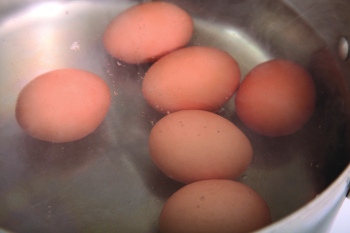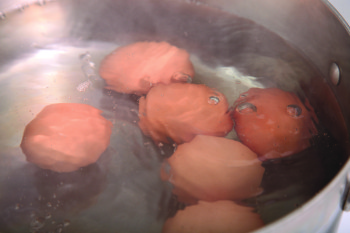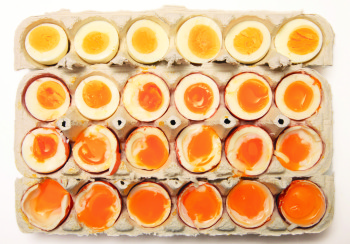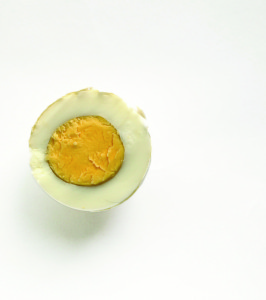November 25, 2015
Understanding The Science Behind The Perfect Boiled Egg
BOILED EGGS
Boiled eggs are about the simplest recipe in any cook’s repertoire, right?
But how often do you get truly perfect boiled eggs? Hard-boiled eggs should have fully set, but not rubbery, whites surrounding yolks that are cooked through but still bright yellow and creamy, with no hint of chalkiness or crumbling, and certainly none of that dreaded sulfurous green tinge at the yolk-white interface that overcooked eggs acquire. Soft-boiled eggs, on the other hand, should have fully set whites with liquid yolks that ooze out like a soft custard, bathing your toast in their golden flow and enriching your crisp bacon. There’s more to boiling an egg than meets the eye. Much more.
Nearly every basic cookbook offers a different technique for how it should be done: start the egg in cold water, or gently lower it into boiling water; add vinegar to the water to lower its pH, or add baking soda to the water to raise it; cover the pot, or don’t cover it; use old eggs, or use new eggs; and on and on. But very few offer evidence as to why any one of these techniques should work any better than another. Apparently, boiling eggs is not . . . ahem . . . an eggsact science. Let’s try and change that.
What Is Boiling?
First things first: what exactly is boiling? The technical definition is that it is what occurs when the vapor pressure of a liquid is greater than or equal to the atmospheric pressure that surrounds it. Let’s go back to the chicken coop analogy we used on page 29. Your pot of water is a coop full of chickens. The chickens tend to like each other and happily stick together inside the coop. Now, let’s say we start adding energy to the mix by switching their water supply out with coffee. With the added energy, the chickens begin to become hyperactive—one or two of them might even be so energetic as to be able to jump the fence and escape. Add enough energy to the mix, and eventually the chickens will become so hyperactive that they’ll tear down the fence and begin escaping very rapidly indeed.
Boiling water is the same thing. The water molecules are trapped in the pot and kept in place by their own fence—the pressure of the air in the atmosphere pushing down on them. Add energy to the pot in the form of heat, and water molecules begin to start leaping off the surface of the water. This is called evaporation. Eventually the pressure produced by the water molecules trying to escape becomes equal to or greater than the pressure of the atmosphere pushing down on it. The fence breaks, the floodgates open, and water molecules rapidly jump from a liquid state to gas, bubbling up violently. This conversion of liquid water to water vapor (steam) is what you see when you look at a pot of boiling water; with pure water at sea level, this occurs at 212°F (100°C).
Here’s a quick rundown of what happens when you bring a pot of water to a boil:
Quivering: At between 130° and 170°F, tiny bubbles of water vapor begin forming at nucleation sites (more on those later) along the bottom and sides of the pot. They won’t be large enough to actually jump and rise to the surface of the water, but their formation will cause the top surface to quiver a bit.
Subsimmer: At between 170° and 195°F, the bubbles from the sides and bottom of the pot begin to rise to the surface. Usually you’ll see a couple of streams of tiny, champagne-like bubbles rising from the bottom of the pot. For the most part, however, the liquid is still relatively still.
Simmer: At between 195° and 212°F, bubbles break the surface of the water regularly, and from all points—not just a few individual streams, as in a subsimmer.
Full boil: At 212°F, bubbles of water vapor escape extremely rapidly. This is the hottest that water can get at sea level without the aid of a pressure cooker.
HEAT AND EGGS
Though some people claim that adding salt, vinegar, or baking soda to the water when you boil an egg can affect its final texture, in my testing, I found that the only factors that matter when boiling an egg in its shell are time and temperature.
To find out exactly how fast an egg cooks in boiling water, I cooked a dozen and a half eggs, removing them from the pot at 30-second intervals before splitting them open.
Now, there are a few things you’ll notice immediately. First and most obvious is that the longer you keep an egg in boiling water, the hotter it gets. But here’s something more important, which may seem trivial at first, yet, as we’ll see, is instrumental in a perfectly cooked egg: foods in a hot environment cook from the outside in, and the bigger the temperature differential between the food and the environment, the more uneven the cooking will be.
What this means is that if you lower an egg into boiling water, it’s possible to achieve an end result with a white that’s tough, rubbery, and overcooked while the yolk is still just barely cooked in the center, like this one:
So, what’s the ideal temperature to cook an egg to? Here’s what happens to an egg white as it heats up:
From 130° to 140°F: As the white gets hot, its proteins, which resemble coiled balls of yarn, slowly start to uncoil.
At 140°F: One of these uncoiled proteins, ovotransferrin, begins to bond with itself, creating a semisolid matrix that turns the egg white milky and jelly-like.
At 155°F: The ovotransferrin has formed an opaque solid, though it is still quite soft and moist.
At 180°F: The main protein in the egg white, ovalbumin, will cross-link and solidify, giving you a totally firm but still tender white.
Beyond 180°F: The hotter you get the egg, the more tightly the egg proteins bond, and the firmer, drier, and more rubbery the egg white becomes. Eventually, hydrogen sulfide, or that “rotten-egg” aroma, begins to develop. Congratulations: your egg is overcooked.
Excerpt from The Food Lab: Better Home Cooking Through Science by J. Kenji López-Alt. Copyright © 2015 by J. Kenji López-Alt. With permission of the publisher, W. W. Norton & Company, Inc. All rights reserved.







